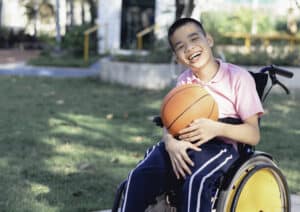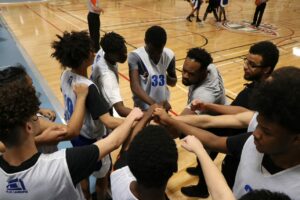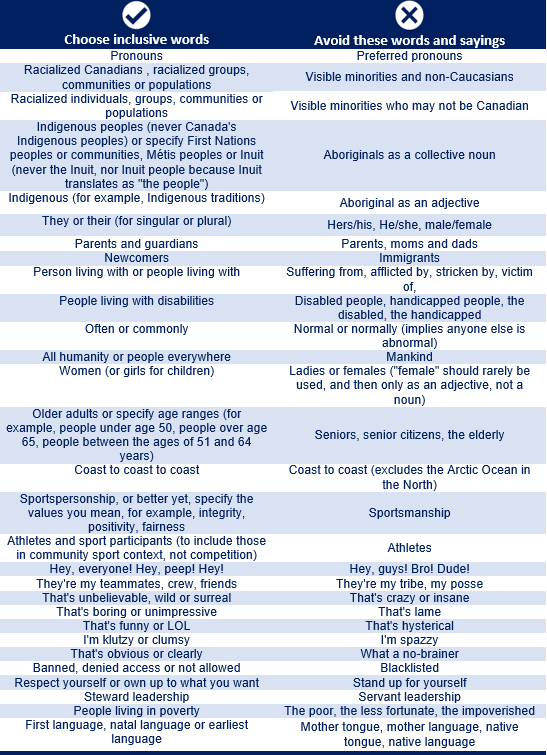Play is a right of all children, but not all children have the same opportunities to experience play. An inclusive playground means having wide entry spaces free of obstacles, ramp access, shaded space, trained staff, and different types of sensory, solitary, and creative play components. A new Inclusive Playgrounds resource presents evidence-informed recommendations designed to enable inclusion and participation of children with disabilities.
To mark World Inclusion Day (October 10, 2022), SIRC wanted to focus on information about inclusive communications in sport. This blog post emphasizes why sport administrators, sport organizations and coaches should improve how inclusive they are, specifically in all the ways they communicate. It also highlights ways to check communications to make everyone in their audiences feel included, respected, accepted and valued.
Inclusivity has nothing to do with political correctness. Everyone has the right to be communicated with in a respectful, accurate and equitable way, rather than being “othered,” made to feel inferior, demeaned, overlooked or excluded.
Anyone should be able to access communications, in some form, unless the communications are for a specific audience only. For example, a message may be of relevance only to elementary students who are already registered for a July 2023 soccer camp in Brandon, Manitoba.
While organizations are adopting hiring strategies and training plans to encourage more inclusiveness, there’s room to do better. Communications in sport is one area in which everyone from coaches to sport administrators can improve inclusivity. This means more than adding pronouns to your social media profiles and email signatures. It also means going beyond using gender-neutral words like replacing “linesman” with “line judge” or “linesperson.”
Why inclusivity matters
 Efforts to consciously improve inclusivity in sport communications can help reduce how often microaggressions, prejudices and biases are introduced or reinforced. Without such efforts, communications can negatively affect diverse audiences based on their beliefs, abilities, gender, skin colour, income, education, culture, sexual orientation, first language, height, weight, backgrounds or other identities.
Efforts to consciously improve inclusivity in sport communications can help reduce how often microaggressions, prejudices and biases are introduced or reinforced. Without such efforts, communications can negatively affect diverse audiences based on their beliefs, abilities, gender, skin colour, income, education, culture, sexual orientation, first language, height, weight, backgrounds or other identities.
The stakes are high. Without inclusive communications, your messages may not reach or resonate with certain individuals or entire community groups. At worst, you risk unintentionally disrespecting or harming people.
When sport administrators, organization staff or coaches create, share or “like” communications that aren’t inclusive, their audiences will react in different ways. Audiences may overlook a misstep if they know you well. But, even fans will react if they feel they’re repeatedly excluded or disrespected. Such audiences may:
- view you or your organization as less credible
- disconnect by unsubscribing or not opening, reading, following, viewing or listening to your communications
- take offence
- form a negative opinion about you or your organization
- complain to others within the sport community or to influencers
- call out you and your organization publicly (for example, on social media, through blogs or podcasts, in letters to the editor, in interviews with traditional media)
- pursue disciplinary or legal action
Making communications more inclusive
 Inclusion spans all types of communications, such as emails, consent forms, medical forms, registration forms, presentation slides, surveys, speeches, annual reports, consultations, website content, social media posts, emails, videos, letters, signage, announcements, help files, transcripts, meeting agendas and minutes, data reports, team names, everything.
Inclusion spans all types of communications, such as emails, consent forms, medical forms, registration forms, presentation slides, surveys, speeches, annual reports, consultations, website content, social media posts, emails, videos, letters, signage, announcements, help files, transcripts, meeting agendas and minutes, data reports, team names, everything.
To be inclusive, sport administrators, organizations and coaches must be mindful as they plan their communications, before they’re created, approved or shared. Part of planning can be to prioritize the most frequently used communications. Then, after improving those communications, move on to other types. So, maybe start with emails and social media content, then review website content, handbooks, training material, and so on.
Signs that your communications could be more inclusive might be that you’re using words that reflect outdated views of families. For example, you might currently be addressing emails to “parents” instead of to “parents and guardians” or your forms might have a line only for “parent’s signature.” That doesn’t account for any children and teens who are raised by other family or community members, live in foster care or stay in a group home.
Maybe the term “coast to coast” appears in your messages, instead of “coast to coast to coast” to account for all Canada’s bordering oceans (Arctic, Atlantic, Pacific). Or maybe you refer to “he/she” or “his/hers” when you could avoid using gender pronouns. Or maybe your memes and photos only show people of one gender, who are white and without disabilities. If so, what steps can you take?
Strategies to improve inclusivity
 Missteps happen, language evolves and demographics change over time, so you won’t always get everything right. What matters is that you learn from any mistakes and strive to do better. Asking people how they want to be addressed and what terms you may use when communicating about or to them.
Missteps happen, language evolves and demographics change over time, so you won’t always get everything right. What matters is that you learn from any mistakes and strive to do better. Asking people how they want to be addressed and what terms you may use when communicating about or to them.
Remember to also consider everyone who communicates on your behalf. For example, an assistant coach may send out messages when you’re on vacation or someone else may manage social media posts for your organization. Make sure they’re all aware of the steps you’re taking to be more inclusive.
Sample strategies:
- Provide communications in multiple formats, whenever possible (audio, video or infographic content may be better for people who live with dyslexia or attention deficits, experienced concussions or have learned English or French later in life)
- Create a list of respectful, inclusive words or terms to replace outdated or non-inclusive ones (see examples in Table 1) and tweak that list as you learn more
- Choose visuals, interviews and focus groups that include people reflecting the diversity of those with whom you communicate
- Aim for person-centred language (ask their chosen words, acronyms or initialisms such as LGBTQ2 or 2SLGBTQIA+), and if it’s not possible to ask, use person-first language (“person experiencing homelessness,” not “the homeless”)
- Delete courtesy titles or salutations like Ms., Mr., or Dr. (for people with a Ph.D.), and instead insert the person’s initials or full name (or use Mx. in cases when you can’t avoid a courtesy title and don’t know someone’s gender)
- Be an inclusivity model and advocate for inclusion
- Consider whether skin colour, gender, age, abilities, religion, culture, physical attributes or other dimensions and characteristics are relevant (if not, don’t add them, and if relevant, be specific, clear and respectful)
- Switch from passive to active voice
- Write in the second person (you, your) to avoid listing multiple gender pronouns
- Make nouns plural to simplify use of “they” and “their” or adopt singular “they”
More inclusivity tips are available in the resources at the end of this blog post.
Table 1. Sample words to replace non-inclusive words

Relying on top line averages and rankings can perpetuate inequality in sport. But examining data through the lens of demographic factors can help organizations to take meaningful action toward equity in sport. MLSE LaunchPad’s 4 pillars of Transparency, Trust, Trying (it out) and Talking (it out) can help sport organizations improve their measurement and evaluation plans.
Family, friends, and teammates all play an important role in encouraging moms’ physical activity and sport participation. There are many ways to support moms to help them stay active. These include helping with childcare and household work, providing moms with emotional support, and most importantly, cheering them on every step of the way!
